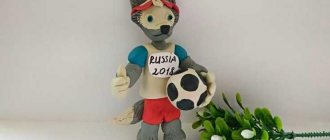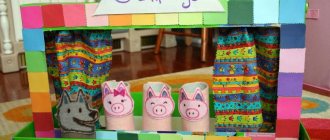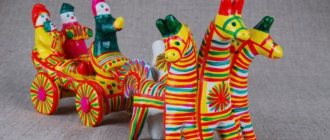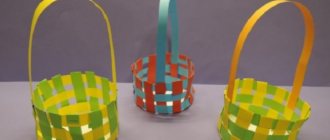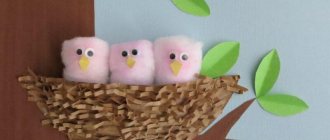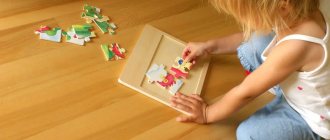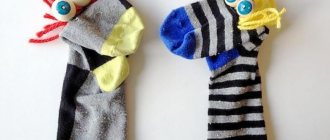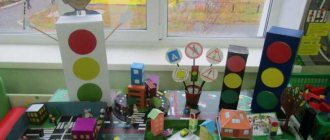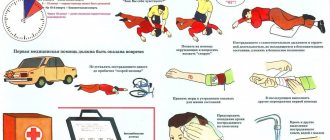What is better to make a craft from?
The best material for crafts:
- salty dough;
- paper;
- plasticine.
But you shouldn’t limit yourself to this. DIY crafts help develop an aesthetic sense, and in addition they can contribute to the formation of environmental awareness and teach the philosophy of rational use of things.
Now is the time to give a second life to a broken umbrella, a burnt-out light bulb, or a Christmas tree ball, or to decorate flower pots. The space theme is perfect for this. Fluorescent paint will always help hide imperfections and emphasize the style and main idea.
For different ages
It is advisable to choose which craft should be made, taking into account the age of the child. Of course, moms and dads will still have to help their child, but this should be his victory. Achievements are difficult to share among everyone, just like success, praise, and good grades.
Preschoolers can create figurines, paintings, and soft toys. It is worth paying attention to photo frames, greeting cards, stained glass, and Christmas tree decorations. But decorating covers for books and notebooks will not be interesting for children at this age, since reading and writing skills have not yet been developed or honed. Primary school students will like this idea more.
Crafts made from wood, wire, matches - “aerobatics”, an interesting task for children studying in the 5th, 6th, 7th or 8th grade.
SOCIAL DESIGN IN PRESIDENTIAL ORDERS. “CREATION OF THE MINI MUSEUM “MYSTERIOUS SPACE”
SOCIAL DESIGN IN PRESIDENTIAL ORDERS.
“CREATION OF THE MINI MUSEUM “MYSTERIOUS SPACE”
Modern requirements for a developing subject-spatial environment are set out in detail in one of the main regulatory documents regulating the education of preschool children - the Federal State Educational Standard for Preschool Education, which regulates the organization of a developing subject-spatial environment not only in groups and other premises directly intended for educational purposes (for example, in music and physical education halls), but also involves the maximum realization of the educational potential of the entire space of the preschool organization (corridors and other recreational areas).
Having analyzed the content of our educational program, developed on the basis of an exemplary general educational program for preschool education “From birth to school” (edited by N.E. Veraksa, T.S. Komarova and M.A. Vasilyeva) and the developmental subject-spatial one already available in the preschool educational institution environment, having weighed all the pros and cons of our “free” room, we decided that it was the most optimal for placing materials on introducing preschoolers to space.
To solve this issue, we turned to museum pedagogy as an innovative technology in the field of personal education of children, creating conditions for the immersion of the individual in a specially organized subject-spatial environment. We decided to create a mini-museum “Mysterious Space”.
When discussing the content of our mini-museum, we primarily focused on the tasks implemented in the preschool educational program, on the age characteristics of preschoolers, took into account the requirements of the Federal State Educational Standard for the developmental environment and the principles of creating a mini-museum, not forgetting about fire safety requirements (the premises are located on main escape routes and should not be cluttered with any objects).
Brief description of the project:
Direction of the social project:
Improving the quality of the educational process in a preschool educational organization in the context of the implementation of the Federal State Educational Standard for Education.
Project implementation timeline:
Start date: 10/14/2019
End date: 04/12/2020
duration: 6 months
Project geography:
Nizhneilimsky district, Zheleznogorsk - Ilimsky,
MDOU "CRR - kindergarten "Yolochka"
Relevance of the project
“When we fully explore space, it will turn out that while we were here on earth, we were already in the sky.”
Stanislav Jerzy Lec
It is difficult to say which of the children does not dream of space, even if the profession of an astronaut in the modern world is not the most relevant for them. But space, so incomprehensible, unknown, distant, excites children’s imagination. Modern cartoons also contribute to this. They overlap between truth and fiction: Star Wars, space pirates, and strange alien creatures misinform preschoolers. Children's ideas about space are not correct and accurate enough. Moreover, they are superficial and often false. The child does not understand what is reality and what is fiction.
Dough astronauts
Safe material, environmentally friendly, the dough is made from flour, water and salt. The craft will be intact even after a couple of years with careful handling. It can be placed on a shelf, in a sideboard or on a windowsill.
What do you need for work?
The consistency of the dough should resemble plasticine. It should be used to fashion astronauts, UFOs or stars, or a rocket.
Needed for work:
- wooden or plastic board;
- knife for sharpening details;
- a little flour so that the dough does not stick to your hands.
It is recommended to first draw a sketch and then start sculpting. It will be easier to work. A day or two will pass and the figurine will completely harden. You can dry it in the oven when you don’t have time and want to do everything quickly. After this, you should start painting. You will need watercolors, gouache, fluorescent or food coloring.
Special box for figurines in no time
In a cardboard box of suitable dimensions, you need to cut out one or two sides. Then color it from the inside, draw the stars, galaxy, Earth, Moon or Sun, Neptune. You can paste scraps of fabric onto its walls, attach them with a stapler, or carefully sew them on.
In such a box, all the figurines sculpted before will look great. It will be the finishing touch and is very easy to make. It can be taken to kindergarten or school. Everyone will surely like it.
DIY ideas for crafts on the theme of space from waste materials
It is becoming more and more popular to make crafts from waste materials (from scrap materials), in other words, whatever you have at home will definitely come in handy for creativity. Oh, do you also think that there is no need to throw things in?
